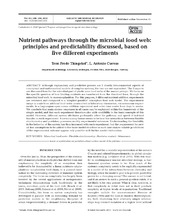Nutrient pathways through the microbial food web: principles and predictability discussed, based on five different experiments
Peer reviewed, Journal article
Published version
Permanent lenke
http://hdl.handle.net/1956/4476Utgivelsesdato
2010-11-11Metadata
Vis full innførselSamlinger
Originalversjon
https://doi.org/10.3354/ame01452Sammendrag
Although explanatory and predictive powers are 2 closely interconnected aspects of conceptual and mathematical models of complex systems, the two are not equivalent. The 2 aspects are discussed here for the microbial part of photic zone food webs of the marine pelagic. We focus on the specific question of how limiting nutrients are transferred from the dissolved form, through the microbial food web, to mesozooplankton. For this purpose, 5 different nutrient addition experiments are reviewed and compared to a ‘simplest possible’ conceptual food web model. The experiments range in scale from artificial food webs constructed in laboratory chemostats, via mesocosm experiments, to a Lagrangian open-ocean addition experiment and cover time scales from days to weeks. We conclude that main system responses in all cases can be explained within the framework of the simple model, and that each experiment therefore also adds credibility to the basic concepts of this model. However, different system attributes profoundly affect the pathway and speed of nutrient transfer in each experiment. A re-occurring theme seems to be how the interactions between flexible stoichiometry and predatory processes modify experimental outcomes. Understanding the flexibility in the behavior of the system has thus increased with each experiment, but the requirement for new ad hoc assumptions to be added to the basic model structure in each case makes reliable predictions of the experimental outcome appear only possible with further model elaboration.
Utgiver
Inter-ResearchOpphavsrett
Inter-ResearchCopyright Inter-Research 2010. Published Open Access.
